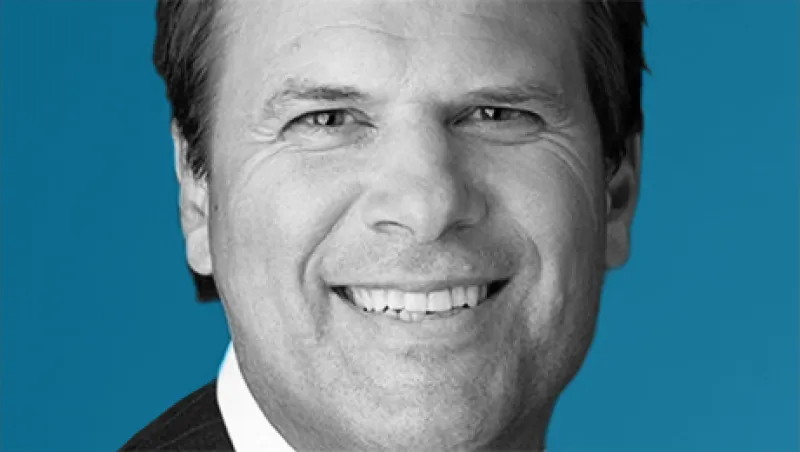Navigating today’s low interest rates is especially daunting for insurance companies, which load up on fixed-income products to match their liabilities and meet regulators’ capital requirements. Since becoming CIO of MetLife in 2011, Steven Goulart says his role has been “re-risking” the insurer’s $500 billion general account portfolio after the firm shed riskier assets in the wake of the global financial meltdown. Under his direction the 800-strong investments team, based in Morristown, New Jersey, has locked in yield by jumping back into areas deserted by investors.
During almost a decade with MetLife, Goulart, who holds an MBA from Harvard Business School, has racked up his share of achievements. In 2012 the Stockton, California, native formed MetLife Investment Management, which has attracted some $10 billion from pensions, sovereign wealth funds and other insurance companies to invest in real estate equity, commercial mortgages and private placement debt. Goulart helmed the mergers and acquisitions unit from 2006 until he moved to the investments department after orchestrating the largest takeover in the company’s history: the 2010 purchase of American Life Insurance Co. for $16.2 billion.
Staff Writer Jess Delaney recently sat down with the 57-year-old CIO on the 41st floor of MetLife’s midtown Manhattan headquarters. With the Empire State Building visible in the window behind him, Goulart calmly reflected on the challenges facing insurers today, from low interest rates to the threat of new regulations — which looms large for MetLife after U.S. regulators in December designated it a nonbank systemically important financial institution (SIFI), a status it is contesting.
How would you characterize the current investing environment and its challenges for insurance companies?
The biggest thing today is interest rates. We’ve continued to battle this low interest rate environment for the past few years, but asset-liability management helps you through that. Presumably in a lower rate environment, our liabilities have lower rates on them as well. As long as we’re pricing our liabilities right, we usually start in a position where we’re okay, and then it’s about finding the best assets given the cost of the liability.
However, rates do hurt because we’re always reinvesting too. Something like a structured settlement might be 40 years long, and you can’t find matching assets. You always have that reinvestment risk, which has probably been the most dramatic thing for us over the past three to four years. As I’ve said on our earnings call, we reinvest billions of dollars a quarter as assets mature, and unfortunately, the rates we’re losing on that roll-off are 100 to 150 basis points higher than what we’re able to reinvest it in today. So there’s a built-in bias in the portfolio to see a declining yield, but we’ve still found ways to offset that.
There’s clearly much less liquidity in the markets, most notably in off-the-run Treasury securities, smaller corporate bond issues and older corporate bonds. To us that’s important because corporate bonds are the single biggest asset sector in our portfolio. Because we’re not short-term traders, we can take illiquidity risk in the portfolio. But we want to make sure it isn’t a permanent change in the market because then we would have to think about some of our securities and valuations differently.
Do you think the Federal Reserve will raise rates this year, and what trajectory do you expect?
My view is that the Fed really wants to move, but they’ve put themselves in this box of being data-dependent. There is still a lot of mixed news out there. For example, there’s no inflation risk and the jobs data is good, but the wage growth really isn’t. That all said, I’ll think they’ll move in December because the data won’t be fully positive enough by September.
From there I think they’ll continue to be in the data-dependent bucket. I think it’s going to be a slower upward trajectory than we’ve seen historically. If the economy isn’t showing additional growth as a result, they’re probably going to be less inclined to keep raising rates because they don’t want to force a recession.
In a low-yield environment, how do you meet your return targets while maintaining the more conservative risk profile required of insurers?
We try to stay one step ahead of the general market. The size and diversification of the portfolio really help because we understand the basics of different asset sectors. We’ve been continuing to find good private asset opportunities. Private placements in infrastructure are an example where I think we’re ahead of a lot of our peers.
We’ve also had very big origination platforms in commercial mortgages. When we came out of the financial crisis, banks and other insurance companies had pulled back from that market, and we were early getting back into it. People have jumped back in over the past three years as well, so we’re starting to see those opportunities narrow.
We’ve also looked for new asset sectors that make sense from an ALM and a risk perspective. Examples would be in the residential mortgage loan area, where we’ve done different variations of whole loans and reperforming loans. A lot of that was driven by the global banks’ need to shrink their balance sheets. They all had big mortgage portfolios, and given our expertise and capabilities in that area, we were able to work with them to structure good opportunities for us.
Where do you see the most attractive fixed-income investments, given low rates and ongoing uncertainty in sovereign debt markets?
Where we see our best opportunities are in commercial mortgages, agriculture lending and residential whole loans. Another thing we’ve been able to take advantage of is the little spurts of market volatility arising from liquidity issues. In both the investment-grade and high-yield corporate bond sectors, we’ve seen opportunities to find a block of securities that we think are trading very attractively given that volatility. That’s not the regular ongoing business like mortgages, but it’s the ability to take advantage of short-term market disruption.
What challenges have regulations presented for MetLife?
It’s hard to talk a lot about regulation because we don’t know where it’s going. We’ve been designated a nonbank SIFI, but there are no regulations that apply to nonbank SIFIs at this point. Certainly the goal of Dodd-Frank and SIFI regulation was to increase capital requirements and make the banks safer, but there are no rules written for nonbanks yet. We stay very involved through our industry associations and directly ourselves in trying to keep the dialogue open with regulators and with Congress.
We’re challenging the nonbank SIFI label. We don’t think that MetLife is systemically important to the overall financial system. But if we ultimately are a SIFI, we want to make sure the playing field is as level as possible. The minute you start saying certain insurance companies are going to be treated differently, that’s going to impact how those companies do business. All those capital charges are going to work their way through into product pricing, which means consumers won’t have as much choice or will pay higher prices.
MetLife’s portfolio is heavily skewed toward corporate debt, mortgage-backed securities and real estate loans. How do you protect yourself against write-downs from changes in ratings?
We have a commitment to credit research and due diligence on those assets. An example would be our roughly $14 billion energy portfolio and what’s happened with oil prices in the past 12 months. A year ago we started restructuring that portfolio, moving it away from some of the lower-rated debt that we knew would be hit first if oil prices were to continue going down.
In commercial mortgages and agriculture lending, we start with a very conservative underwriting perspective as well. Our average loan-to-values are very low for the industry. Because the loans are very conservatively underwritten, they can take a substantial change to the asset value before there’s any real risk to us in those portfolios.
How do you use equities and alternative investments in the portfolio?
Sparingly. Our portfolio is roughly 5 percent equity and 95 percent fixed income. We have approximately $20 billion across three big buckets: real estate equity, private equity funds and hedge funds. Strong performance in our private equity and hedge fund portfolios has helped offset the drop in yield we see from reinvesting at lower rates when our fixed-income securities roll over. When we look at our total net investment income, the variable investment income component is 7 or 8 percent, and that’s enough to move the needle.
The negative is that as a regulated insurance company, we have to hold capital against every investment we make, and the capital requirements are much higher for equity investments than fixed income. Cash flow management and predictability are difficult for equities and important for asset liability management, so they have a more limited use.
Follow Jess Delaney on Twitter at @jdelaney_NYC.






